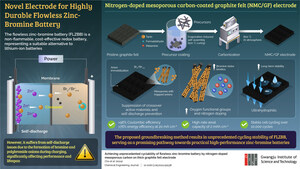Gwangju Institute of Science and Technology Researchers Develop Novel Silk-Based Digital Security Device
With a break time of 5 x 1041 years, this novel digital security system is practically unbreachable, say researchers who developed it
GWANGJU, South Korea, Jan. 28, 2022 /PRNewswire/ -- The global hike in consumerism comes with its own share of problems—counterfeit goods and cyberattacks. Although digital security systems help us combat many of these adverse situations, hundreds of security breaches occur every single year.
One way to address this issue is by using unique physical components that cannot be duplicated or "cloned." A physical unclonable function (PUF) is a physical feature that takes advantage of microscopic differences in electronics to create unique security "keys." These keys, when read by an electronic device, help establish or refute the authenticity of the input, thereby either granting or denying access. Now, researchers from the Gwangju Institute of Science and Technology have designed the first natural PUF. Using native silk fibers obtained from Bombyx mori (domesticated silkworms), the research team designed PUF-based tags. These tags were then used to devise a lens-free, optical (light-based), and portable PUF (LOP-PUF) module.
"When a beam of light hits the disordered silk fibers of an optimal density, it causes light diffraction. The nanostructures in individual microfibers enhance the contrast of light intensity with respect to the background. The diffracted light is then captured by an image sensor. Since the pattern of the microholes is naturally-made, it is unique, giving rise to a unique pattern of light," explains Prof. Young Min Song, senior author and a professor at the Gwangju Institute of Science and Technology.
To achieve the desired intensity and contrast, the researchers experimentally optimized the distance between the silk-based PUF and the image sensor. The assembly also included a light-reflecting mirror and three tricolor light-emitting diodes among other components. Through a series of interventions, the research team processed the captured patterns of light and converted them into a digital format (strings of 0s and 1s).
The results were astounding: the average time required to "fake" the authentication was approximately 5 x 1041 years, thus making the LOP-PUF module a practically unbreachable device. Moreover, the novel security device permitted "digital encryption," or the conversion of information into a code, to prevent unauthorized access.
"The digital security device we designed is low-cost, portable, eco-friendly, and free of pre- or post-processing. It also does not require a coherent source of light or a bulky lens system. The advantages of this system are manifold," says Prof. Song.
The team optimized its LOP-PUF design by adding a few tweaks. For example, a cooling fan was added to reduce the "thermal noise," or the disturbance caused by temperature fluctuations.
Prof. Song muses, "To our knowledge, this is the first PUF module designed using silk, a naturally abundant biomaterial. It means that we don't need to invest time in developing complicated security keys, nature has already done this for us."
Silk-based PUFs have indeed secured their place as a pioneering, sustainable and environmentally-friendly digital security solution!
Reference
Authors: Min Seok Kim1, Gil Ju Lee1,2, Jung Woo Leem3, Seungho Choi4, Young L. Kim3,5 & Young Min Song1,6,7
Title of original paper: Revisiting silk: a lens-free optical physical unclonable function
Journal: Nature Communications
DOI: https://doi.org/10.1038/s41467-021-27278-5
Your Press Release Source
Gwangju Institute of Science and Technology
About the Gwangju Institute of Science and Technology (GIST)
please visit: http://www.gist.ac.kr/
Corresponding authors' email: [email protected]; [email protected]
Contact:
Seulhye Kim
82 62 715 6253
[email protected]
SOURCE Gwangju Institute of Science and Technology

WANT YOUR COMPANY'S NEWS FEATURED ON PRNEWSWIRE.COM?
Newsrooms &
Influencers
Digital Media
Outlets
Journalists
Opted In





Share this article